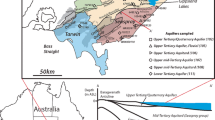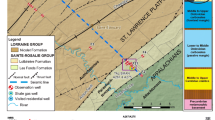Abstract
The baseline methane for shallow groundwater can provide an important evidence to interpret possible methane stray associated with shale gas exploration. This study investigated and traced methane content and its origin of shallow groundwater in a karst aquifer in the Fuling shale gas block, SW China. The results show that methane contents of shallow groundwater are all less than 0.01 mg L−1 and volumetric content in dissolved gas ranges from not detected to 0.0064%. The δ13C-CH4 ranges from −74.4 to −49.1‰, suggesting biogenic origin. For the first time, the δ13C-CH4 and 3He/4He end-numbers were determined.





Similar content being viewed by others
References
Vidic RD, Brantley SL, Vandenbossche JM, Yoxtheimer D, Abad JD (2013) Impact of shale gas development on regional water quality. Science. doi:10.1126/science.1235009
Vengosh A, Warner N, Jackson RB, Darrah T (2013) The effects of shale gas exploration and hydraulic fracturing on the quality of water resources in the United States. Procedia Earth Planet Sci 7:863–866
Guo X (2014) Shale gas enrichment mechanism and exploration technology in Jiaoshi block of Fuling gas field. Science Press, Beijing
China Geological Survey (2015) The shale gas resources in China. Geological Press, Beijing
Kharaka YK, Thordsen JJ, Conaway CH, Thomas RB (2013) The energy–water nexus: potential groundwater-quality degradation associated with production of shale gas. Procedia Earth Planet Sci 7:417–422
Vengosh A, Jackson RB, Warner N (2014) A critical review of the risks to water resources from unconventional shale gas development and hydraulic fracturing in the United State. Environ Sci Technol 48(15):8334–8348
Warner NR, Jackson RB, Darrah TH, Osborn SG, Down A, Zhao K, White A, Vengosh A (2012) Geochemical evidence for possible natural migration of Marcellus Formation brine to shallow aquifers in Pennsylvania. Proc Natl Acad Sci USA 109:11961–11966
Osborn SG, Vengosh A, Warner NR, Jackson RB (2011) Methane contamination of drinking water accompanying gas-well drilling and hydraulic fracturing. Proc Natl Acad Sci USA 108:8172–8176
Clark ID, Fritz P (1997) Environmental isotopes in hydrogeology. Lewis, Boca Raton
Etiope G, Schoell M (2014) Abiotic gas: atypical, but not rare. Elements 10:291–296
Fuex AN (1977) The application of stable carbon isotope in the exploration of oil and gas. J Geochem Explor 7:155–188
Institute of Geochemistry-Chinese Academy of Sciences (1998) Advanced geochemistry. Science Press, Beijing
Dai J, Zou C, Zhang S, Li J, Ni Y, Hu G, Luo X, Tao S, Zhu G, Mi J, Li Z, Hu A, Yang C, Zhou Q, Shuai Y, Zhang Y, Ma C (2008) Discrimination of abiogenic and biogenic alkane gases. Sci China Earth Sci 51:1737–1749
Welhan JA (1987) Characteristics of abiotic methane in rocks. In: Fritz P, Frape SK (eds) Saline water and gases in crystalline rocks, Geological Association of Canada Special Paper 33:225–233
Jackson RE, Gorody AW, Mayer B, Roy JW, Ryan MC, Van Stempvoort DR (2013) Groundwater protection and unconventional gas extraction: the critical need for field-based hydrogeological research. Groundwater 51:488–510
Saba T, Orzechowski M (2011) Lack of data to support a relationship between methane contamination of drinking water wells and hydraulic fracturing. Proc Natl Acad Sci USA 108:E663
Schon SC (2011) Hydraulic fracturing not responsible for methane migration. Proc Natl Acad Sci USA 108:E664
Révész KM, Breen KJ, Baldassare AJ, Burruss RC (2010) Carbon and hydrogen isotopic evidence for the origin of combustible gases in water-supply wells in north-central Pennsylvania. Appl Geochem 25:1845–1859
Grasby SE, Ferguson G, Brady A, Sharp C, Dunfield P, McMechan M (2016) Deep groundwater circulation and associated methane leakage in the northern Canadian Rocky Mountains. Appl Geochem 68:10–18
Zhang L, Soeder DJ (2016) Modeling of methane migration in shallow aquifers from shale gas well drilling. Groundwater 54(3):345–353
Schloemer S, Elbracht J, Blumenberg M, Illing CJ (2016) Distribution and origin of dissolved methane, ethane and propane in shallow groundwater of Lower Saxony, Germany. Appl Geochem 67:118–132
Yang R, He S, Hu Q, Hu D, Yi J (2016) Pore characterization and methane sorption capacity of over-mature organic-rich Wufeng and Longmaxi shales in the southeast Sichuan Basin, China. Mar Petrol Geol 77:247–261
Hu D, Zhang H, Ni K, Yu G (2014) Main controlling factors for gas preservation conditions of marine shales in southeastern margins of the Sichuan Basin. Nat Gas Ind 34:17–23
Lü Y, Hu W, Zhou J (2012) Analysis on karst development law and its influencing factors in Jiaoshi area of Chongqing city. Chin J Geol Hazard Control 23(2):59–63
Luo L, Pang Z, Luo J, Li Y, Kong Y, Pang J, Wang Y (2014) Noble gas isotopes to determine the depth of the geothermal fluid circulation. Chin J Geol 49:888–898
Eltschlager KK, Hawkins JW, Ehler WC, Baldassare F (2001) Technical measures for the investigation and mitigation of fugitive methane hazards in areas of coal mining. US Dept of the Interior, Office of Surface Mining Reclamation and Enforcement, Pittsburgh
Fuex AN (1980) Experimental evidence against an appreciable isotopic fractionation of methane during migration. Adv Org Geochem 12:725–732
Bacsik Z, Lopes JNC, Gomes MFC, Jancso G, Mink J, Padua AAH (2002) Solubility isotope effects in aqueous solutions of methane. J Chem Phys 116:10816–10824
Wei X, Guo D, Liu R (2016) Geochemical features of shale gas and their genesis in Jiaoshiba block of Fuling Shale Gasfield, Chongqing. Nat Gas Geosci. 27(3):539–548
Klass DL (1984) Methane from anaerobic fermentation. Science 223:1021–1028
Whiticar MJ, Faber E (1986) Methane oxidation in sediment and water column environments—isotope evidence. Org Geochem 10(4):759–768
Whiticar MJ (1999) Carbon and hydrogen isotope systematics of bacterial formation and oxidation of methane. Chem Geol 161:291–314
Lansdown JM, Quay PD, King SL (1992) CH4 production via CO2 reduction in a temperate bog: a source of 13-C-depleted CH4. Geochim Cosmochim Acta 56:3493–3503
Whiticar MJ, Faber E, Schoell M (1986) Biogenic methane formation in marine and freshwater environments: CO2 reduction vs. acetate fermentation—isotope evidence. Geochim Cosmochim Acta 50:693–709
Cai C, Amranic A, Wordend RH (2016) Sulfur isotopic compositions of individual organosulfur compounds and their genetic links in the Lower Paleozoic petroleum pools of the Tarim Basin, NW China. Geochim Cosmochim Acta 182:88–108
Bottinga Y (1969) Calculated fractionation factors for carbon and hydrogen isotope exchange in the system calcite–carbon dioxide–graphite–methane–hydrogen–water vapor. Geochim Cosmochim Acta 33:49–64
Wang G, Zhang Z, Wang M, Wang J, Liu W, Yi L, Sun M (2003) Geochemistry of geothermal water and noble gases in Yanhuai basin. China Seismol Geol 25(3):421–429
Sano Y (1982) 3He/4He ratios of methane-rich natural gases in Japan. Geochem J 16(5):237–245
Xu S, Nakai S, Wakita H, Wang X (2004) Carbon and noble gas isotopes in the Tengchong volcanic geothermal area, Yunnan, Southwestern China. Acta Geol Sin 78(5):1122–1135
Zhao P, Duo J, Liang T, Jin J, Zhang H (1998) The gas geochemical characteristics of the Yangbajing geothermal field in Tibet. Chin Sci Bull 43(7):691–696
Cao C, Zhang M, Tang Q, Lü Z, Wang Y, Du L, Li Z (2015) Geochemical characteristics and implications of shale gas in Longmaxi Formation, Sichuan Basin, China. Nat Gas Geosci 26:1604–1612
Acknowledgements
This work is supported by the “Strategic Priority Research Program (B)” of the Chinese Academy of Sciences (Grant XDB10030603) and National Natural Science Foundation of China (Grant 41672254).
Author information
Authors and Affiliations
Corresponding author
Rights and permissions
About this article
Cite this article
Huang, T., Pang, Z., Tian, J. et al. Methane content and isotopic composition of shallow groundwater: implications for environmental monitoring related to shale gas exploitation. J Radioanal Nucl Chem 312, 577–585 (2017). https://doi.org/10.1007/s10967-017-5243-9
Received:
Published:
Issue Date:
DOI: https://doi.org/10.1007/s10967-017-5243-9




